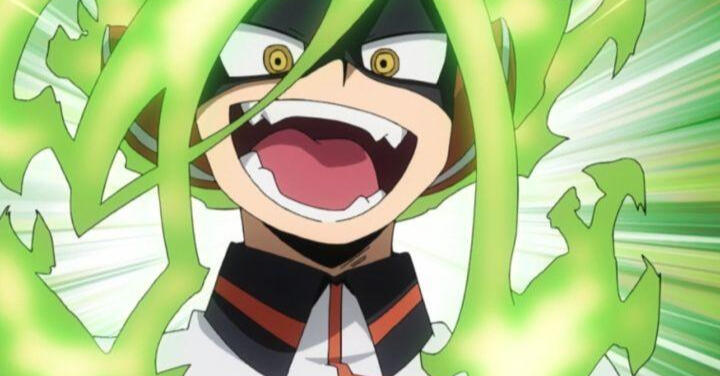Circuit breakers dev blog
Week 1
Our first week started on Wednesday where all the teams were split into small groups, with the main bulk of the work of this day being done by the designers to collaborate on possible game ideas. I helped Ollie design his bug collecting game heavily inspired by Animal Crossing & Pokémon where you catch different bugs from across different regions and areas. With room for storytelling in ruins and challenges with various different bugs that spawn at certain times, rarities and so on so forth. I helped plan out little ideas that might help.At the end of it all, Ollie’s idea wasn’t picked and Sakrita’s idea of a parkour racing game with singleplayer & multiplayer aspects was chosen. I thoroughly liked everyone else’s ideas, but I was really hoping Ollie was picked because our team was very good at making a soft and calming atmosphere in Exteriors. I thought that with our past project being relatively successful, we could pull off the vibe again and put that into this bug collecting game. Creating a nice chill game that would be quite possible for all of us to do in a Triple A setting. However, in hindsight it probably was a good idea since Ollie’s idea is relatively simple and is pretty hard to scale to a Triple-A standard.The main issues I immediately saw with Sakrita’s idea was that it was very ambitious for an inexperienced team, with a team of 4 or 5 programmers to create a movement based racing game. From Exteriors, I feared that the fundamentals of the game - the movement system - would fall short and not be up to par with others in the industry. Then there was also the split between Multiplayer and Singleplayer, let alone the thought of running servers for Multiplayer in general and all the server-side VS client-side issues we would face with all the abilities we had in the game.Audio wise, I believed that this would be relatively simple as there was only so much you can do to add sound to movement, and adding unique character to the powerups that Sakrita mentioned would be the fun part of the project’s sound design. I also already had come up with ideas that we could do for music, being heavily inspired by Payday 2 and The Finals.On the same day, I spent my time writing and experimenting with making a main menu track in inspiration of The Finals. The bass is very trance-like with a very EDM inspired melody and I wanted to replicate that feel. However, I am not very good with synths so I ended up with a track that sounded simply Trance.The idea in my head was that the game was like a The Finals-esque show with a Fall Guys Wipeout course that the players needed to cross to reach to the other side. It seemed very ambitious with the skill level of our other disciplines. I have no doubt in the audio teams’ abilities as Jack is a skilled synth wizard, Aimee is a great orchestral battle musician and Jerrell has all of us to learn off of.There was one part of Triple-A development that had me concerned. That was the Audio Lead position. I was heavily considering it, but I wasn’t sure if I’d be a great fit judging by my track record of not being too active in the community chats and in person. When I was told that we could run for it, I wasn’t too sure I’d even be considered at all since Aimee essentially led Exteriors’ audio design last time. But regardless, I believed in my own abilities as a solid candidate because I am a person who studied A-Level & GCSE Music, and was somebody with a good grasp of sound design and songwriting. I also played a lot of The Finals and Payday 2 which were the main inspirations of the project, with the others not necessarily playing those types of games. I gave my case to the team, but Aimee eventually was voted the role! Which was not wholly surprising given how great she is as a leader.The team decided to start using Jira and Confluence instead of Trello. Since those tools are used by a lot of game developers in the industry. We were also considering switching to Slack instead of Discord for a similar reason, however the consensus seemed to be leaning towards Discord. What we were doing for the first time in the project was actually implementing WWise Middleware into Unity which was something that we were all not accustomed to yet. And we were still questioning if WWise’s version control issues that we were warned about during Exteriors would persist to now. Either way, we decided to continue with it and use Github as our version control of choice.
Week 2
Before the Wednesday lesson, the team leads had a meeting and discussed their problems they were facing. Aimee told me she discussed giving the Audio team roles because she knows about our strengths and weaknesses. When Wednesday came, there weren’t any tasks for me to do. The sprint was a long meeting going over what Programmers, Designers and Artists should do. After the sprint, there still weren't any hard set tasks that I needed to complete which is completely expected. At the start of a Game Development process, more often than not the musicians and audio team usually aren’t given much material to work on. Since the conceptualisation phase still has yet to come, the art style and the music style hasn’t been chosen yet.Despite that, Aimee tasked us to crack on with writing musical ideas based on the Triple-A Audio Research that she made the week before. She said after making all our music, we can get the designers to vote on which one they liked the most and focus our attention on working to that style.The themes that were requested by the designers were very rock heavy inspired tracks. Two that caught my eye were Doom and Roboquest, with very heavy pumping guitars and loud synths. I wasn’t too confident in my synth abilities, but I knew various methods on Logic to get a good sounding guitar.Using Logic Pro X’s stock plugins, I chose a “Sunburst Electric” guitar and added more bass to the GTR Amp plugin. I would also use “Sunburst Electric Power Chords” to get that plucky sound, and use Logic’s Drummer tool to create drums. Using a lead guitar, I would create the main guitar riff that resembled Doom’s energy and would continue to use this energy for the rest of the other tracks. I would layer the drums with another set of drums, either another acoustic or a beat machine depending on the feel of the track. I would also use the “Sunburst Electric Power Chords” to strum the chord progression, and use its singular pluck sound underneath to drive the momentum and fill in the empty space. I would also attempt to use bass guitars, but I still don’t know how to write bass at all.I would make two small tracks, and stay in for a little bit after the session finished to finish my last track. Totalling up to four drafts that might be used in the game, and if not; it could prove useful for either another track for the game or another project entirely.

Week 3
By the time the third week rolled around, I had already posted my tracks to the Discord and was waiting for everyone to send in their tracks for the deadline that was set on 29/01/24. We were still waiting on Jerrell to send his tracks in. We were hoping for a few since we hadn’t heard from him in a while. However, Jerrell only sent in one which is definitely better than nothing. But call it a hunch, but the track he posted didn’t sound like he worked on it very long. Either way, Aimee sorted all the pieces into a Google Drive and made a Google Form for the Designers to fill out and judge the songs based on their sound. It was very entertaining that my experimental acoustic guitar draft managed to enter the pool, but I wasn’t expecting it to get any results either way.

The other pieces that Jack and Aimee made were very well made, and fit the vibes of the game really well. The only piece I was concerned about was Jerrell since it took him half a week to create one draft. In hindsight, I should’ve reached out to Jerrell to ask if he needed any help and I should’ve done so a lot earlier rather than waiting for the deadline to pass by. Since I had already finished my drafts, I had time to spare to help Jerrell.I wasn’t able to attend the meeting on this day due to train strikes, but it was explained to me that Aimee spoke about her plans of setting up tasks and organising the audio asset list for us. Since it would be nice to crack on with the sound effects early.It was also within this week where we received the results of our music back, and to my surprise a lot of my tracks weren’t even picked once. I was even more surprised that the experimental acoustic guitar draft got a vote when some others didn’t. Despite that, we figured out the sort of style that the designers wanted for the game, something very synthy.


Aimee messaged me later on Discord informing me on what the goals were for this week, what tasks I have and explaining how the Jira worked. She said she wanted the final songs to be a minimum of 2 minutes, but wanted a draft of 1 minute so that everyone can get a good start with their songs so we can balance music and sound effect work together.It was at this time I noticed that my Jira account was acting up, so I decided to give it a few days hoping that it was only just an issue with the servers and that it would fix itself in the next week. In hindsight, I should’ve communicated this with my team members as soon as I thought something was up. As this issue would later turn into a bigger issue.The next day me, Jack and Aimee were on campus for our Audio Elective class, and used this time to work on the Triple-A project as well. It was here where we decided to talk about the plans for the music. We decided on having a track that would dynamically change as the player reached the end and back. That meaning, the track would change either to a rock or more intense sounding version as they get chased by the "Red Wall" as they race back to the start.I think this is a really cool concept as it audibly distinguishes the difference between running to the end, and being chased. It creates a sense of tension, and excitement in the Singleplayer campaign. It was also here where I learned fully that there would be no Multiplayer at all. This is where the cracks in miscommunication would form, as this was an early example of being told different things than what was written or agreed on. At this point I was told that Multiplayer would be unlikely to happen, but wasn't told flat out that it was.In the future, I will work on chasing up on these little discrepancies in my knowledge, and make sure that the information I know is up to date.
During 01/02/24, we also talked about using VitalSynth as our go-to synthesizer as Jack doesn't have access to Alchemy in Logic since he's using a Windows / Linux laptop. So a few days later, he posted his Vital Synth patches that he'd been using in his main track. This is the same track that got the most votes by the Designers, so it was very helpful that Jack posted his synths to us. As it was absolutely necessary to have some consistency between all the different tracks composed by different artists.
Week 5
The day before the lesson, I spent all night working on my synth track draft that was due in on the Lesson day. I wanted to make something that was similar to Jack's piece and was able to make something using a mix of Jack's synths and the preset synths on Vital.The drums were made using D&B samples from Bandlab as I couldn't find RF Drums for Logic Pro X and only found versions for Windows. I wanted to make something that was very high energy as the change in tone would come from the change of instrumentation.Before making the melody I would make a gliding bassline that would rise up. I wanted it to have a lot movement so I made it slide from one note to the other so that it didn't sound too flat and bland. For the melody, it was a lot of trial of error and improvising on my keyboard.With every improvisation round I would take out one bit and touch up another, until I reached a certain melody that I was happy with. I was particularly happy with the chordal harmony in the first verse, and the use of repeating arpeggios to add a little bit of spice to the track. Additionally, I really like the way the transitions between each component is broken by a little pause and glitch noise, which was something I was really proud about.I was also very happy with how the extended bridge came out, the emptiness is amplified by the underlying ambient noises that was also taken from Bandlab. The second verse instrumentation, with the main melody using a very legato and sustained synth contrasts so much with the square synth heard in the first verse. So I had them combine together to make a climactic final verse to end off the track.---When I came in late, me and Aimee went through the Audio Asset List to see where we were at. Since I had already finished my synth track, all I had left to do on that day was make the Rock Version and the sound effects that were tasked to me. But I wanted to go over the sounds just one more time just in case we missed anything, or if I am misunderstanding anything. This was when I was told that the powerbox items would be replaced with actual abilities that the player has at the start. The charge and grapple being abilities that would influence the level. I had no idea we downgraded the power system to that, and it would've been nice to know in some sort of announcement or something similar. Me and Aimee cleared up some of the sounds with the designers, and I started work on creating my rock version of my track.I used the same instruments as my older drafts, using "Eighties Electric" with the same effects to achieve a very rock sounding tone. However, there seemed to be something missing and I had no idea what that would be. I thought it was the compression compressing the song too much, but I believe in hindsight it was the bass guitar and the D&B Drums being used which didn't match the Rock theme.
---
The day after, I noticed that the Jira issue I had experienced prior to this was still acting up and I still had no access to the Jira. An issue that I should've raised earlier, but didn't because of a lack of communication on my part. However, it seemed that this issue was beyond me and the team as this Jira issue would still persist even up until the end. I should've mentioned this to Aimee and everyone else, however it was during this time that I became increasingly preoccupied with other work.
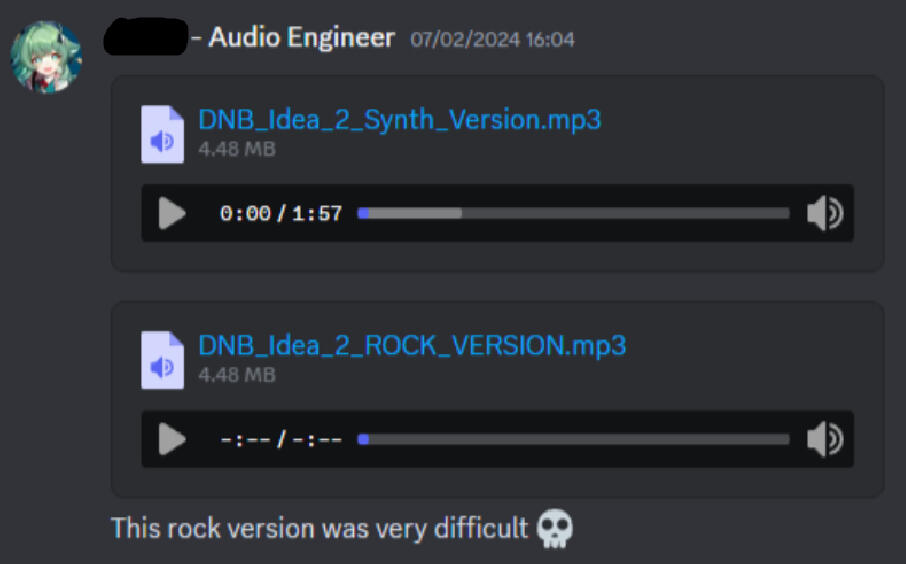
Reading week
During reading week I started work on creating movement sounds. To start off with, I used the testing footage that the designers were using as reference footage as a base to edit on my sounds onto.I used a lot of sounds from SoundQ and edited and combined them together to design a very mechanical sounding footstep. It was a combination of a mech stomp and a gas pressure release. Being heavily inspired by the heavy impactful sounds of Yasumasa Koyama, I wanted every jump and landing to have a wind up. So in this example, I chose to add a slight riser before the player lands onto the ground.The sliding was accomplished by combining a scraping metal sound with a sword unsheathing to get a starting sound.The jump was made from a piston added with another mech step sound effect layered together to accomplish a powerful hydraulic jump.The Designers gave feedback saying that it was very mechanical and fitted the atmosphere, but it was missing that synth aspect that the final design needed. So I added a slight synth "beep" every time the player took a step, and added a more electrical effect to the riser to give that synth-like character to the sound.

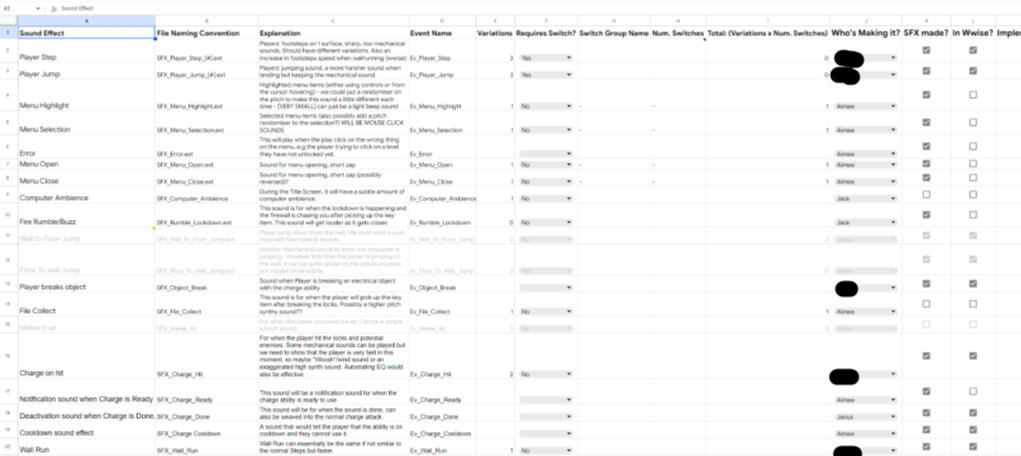
Week 5-6
On week 5, something personal happened that forced me to leave that I cannot talk about.
---
The week after into Week 6, I experienced it all. First of all, it was a mess with there being only 8 people in. Two leads and both Team Lead and Producer were absent, so we had to reschedule the sprint. This is obviously not indicative of a Triple-A environment as not having a sprint seriously jeopardizes the workflow. We are unable to understand where everyone is at, and with only 8 people in, we can't get updates from them either.Despite that, Aimee was the only other audio member present as the others were ill. She helped me set up WWise with the Circuit Breaker Unity Project as I hadn't set it up yet due to focusing on creating the sounds and music.I started work on fixing my Rock Version of the song, and left my sound implementation for later on in the week as all my sounds were on my PC at home and not at my macbook that I brought with me.
Week 7
Unfortunately, I was unable to do any sound implementation. Thanks to the events on Week 5, I was unable to do any work until the actual day of the lesson. I hadn't communicated this with Aimee or any of the team members so they were left in the dark on my status or what I was doing this entire time. Which I unfortunately couldn't go into much detail. In hindsight, telling them something would've been the best course of action. Telling them I was busy with personal reasons, it didn't need to be specific at all. This isn't indicative of a Triple-A workflow. I'm expected to inform the team leads about my status on that day, the progress of my work and communicate any grievances or events that may impede my workflow. Which is exactly what I didn't do.Despite that, on that day I entered a flow state and managed to create turret sounds that were made using sounds that I got from a recently acquired Humble Bundle pack from Ovani Sound. The gunfire sounds were made by combining a "Shotgun Omnibarrel" with a "Punchy Shot" from Hollywood Action pack. I compressed them and EQ'd it to make sure it matches the mechanical sounds from a different pack.The "Ready" sound was made using a synthesizer and making a dissonant clash between two notes a minor 2nd apart. Adding reverb to it, it sounded like it was a powerful turret that reflected the gunfire sounds. I also added a touch of mechanical movement to give the impression that the turret literally "clicked on" as it saw the player.The "Riser" sound was made using a SoundQ riser and combining it with a chain locking sound. I also played around with adding an anime-esque "whistle" noise at the end of the riser just before the gunfire starts, just like how an attack is done in a shounen anime. However, it just didn't fit with the style of the game and was scrapped.
----
I also used this moment to properly fix the rock version of the synth track. I replaced the old drums with a Logic Drummer and layered two acoustic drums over each other to create presence and rhythm. I also changed the effects I put on the guitars, instead of using the GTR AMP it came with, I chose one of Logic Stock AMPs and set it to the Heavy Rock preset.I also added a harsher, distorted bass guitar to fill in the emptiness in the lower frequencies, and also added back in the synth in Verse 2 to help drive the guitar melody.
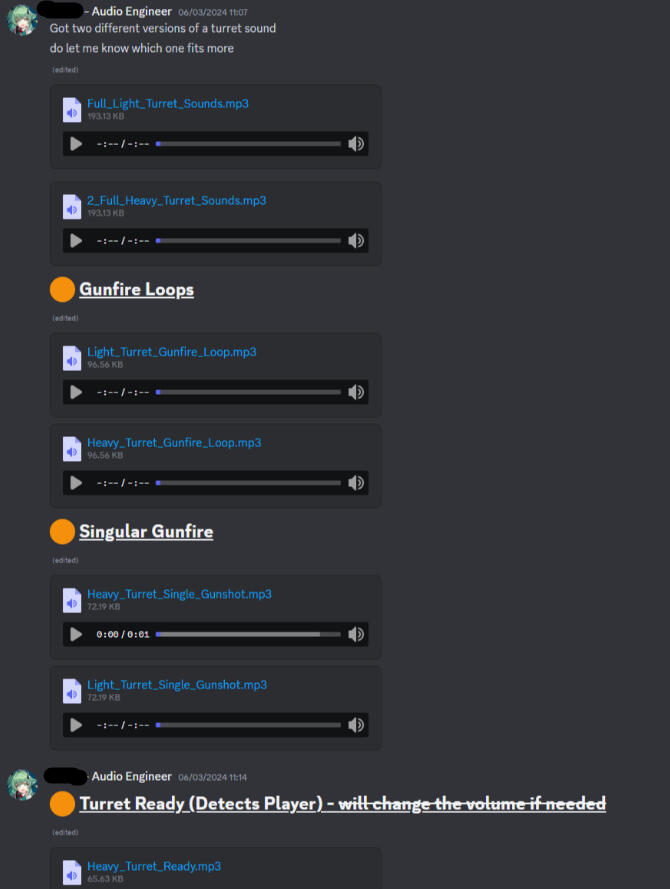
Week 9
Being very busy with personal life, I had no time to do anything. But, like on Week 7 I was able to do work on the lesson day.I used that day to finish off the sounds that I missed in the past few weeks. That being notably the charge sounds and specific sounds related to the turret. I was also very curious, so I did a full hypothetical sound test by adding all the current sounds created into an audio-only demo of the game. Using this I was able to figure out what sounds sounded off, and what needed mixing or what was fine.I created the charge hit by stacking an explosion sound, electrical effect and wooden debris to give that breaking sound.For the turret bullet fly by, it was a simple woosh noise that I bass boosted, slowed and compressed to give emphasis on how powerful the bullet of the turret is; Since it can push a player off the map in just one bullet.The charge ramp up was done by using a "futuristic organic effect" from SoundQ and combining multiple sci-fi laser charge up sounds. I automated a pitch shifter to rise on an underlying sci-fi laser charge up to accentuate the mechanical nature of the player.
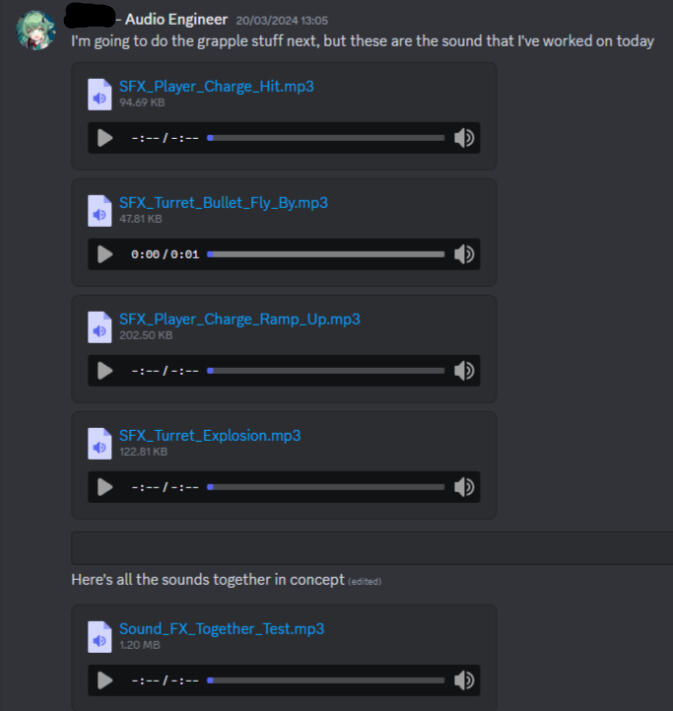
Week 11
Following from Week 9, I was still extremely busy with my personal work that I couldn't do too much. So I spent an entire night just working on implementing all the sounds into the WWise project.It was a simple as downloading and converting my MP3 sounds into WAVs and dragging them into the Sound Effects Audio Work Unit. However, I didn't like how everything was organised so I added folders to better manage all the sound effects and events in the game. I am incredibly thankful that I chose to follow the naming convention at the very start of the project's development. It meant that I could simply implement the audio without worrying about keeping to the naming conventions. This is especially prudent in the music creation where I had to remember the tempo, time signature and the length of bars that the individual parts took up.This is a great example of a Triple-A workflow working out in my favour, as parity between individual member workflows such as naming conventions allows members to work on each other's files without worry. They don't need to decipher anything and chase anyone up, since they can simply learn everything about that file from the just the name alone.


It was also here where I implemented my music. I had already bounced all of the stems and individual parts of the song. But I had no idea how to structure the song to randomise in the right way I wanted.With the help of Jack, I was able to figure out where to find the Music Mixer Hierarchy and edit the play order of all my song parts. My plans for my track were way different than the others. I essentially had two songs with a complicated randomisation order. For example, it could play "Bridge A + Bridge B" or play "Bridge A" then move into either "Verse 2 + Verse 3" or "Verse 2 + Transition + Verse 3". Additionally, each verse music segment also has a random step track where it would either play an empty sub-track or the melody track.With all of that, this song - both in rock form and synth form - has multiple different combinations of how its played. Meaning that every time it plays ingame, the structure is never the same and can potentially keep the player engaged further in game.

Week 12
In the final week, I finished off all my tasks and ticked off everything that I've done. That includes all the grapple sounds, electrical fence sounds and barrier breaking sounds.What was interesting to make was the grapple sounds which I'm still unsure of. I chose to use a bicycle chain moving as the reel in, but I believe that it just sounded too slow. The firing sound of the grappling hook is also very similar to a turret, so I do worry that the player might mistake the grappling hook as a turret if they didn't know any better. If the week 5 situation hadn't happened, I would've made a faster bicycle chain sound by myself and change the grapple hook fire sound to a more "launcher"-like sound. Originally I was very inspired by the ODM gear from Attack On Titan, but it was hard to replicate the sound without directly copying it. If I had more time, I would've tried to find more way to create a grapple sound effect that was not only unique, but also interesting for the player.Other sounds were made by using sounds related to the name.
--
I also created the main menu theme based on the trance draft that I created at the start of the development cycle. This time it incorporates all the melodic ideas of all tracks seen in the game. That means Jack, Aimee, Jerrell and my tracks all combined into a calmer piece. The main difficulty was trying to incorporate different rhythms and different writing styles into one trance-like theme with its own rhythm.I first started off with Aimee's very unique Tonic to Minor 3rd to Major 2nd to Perfect 4th melody. It's unlike everything in the game and stands out if there is no rhythmic change. So I tried to add in more notes to fill in the rhythm and follow the very jazzy-like feel the song has.Secondly, I worked on incorporating both mine and Jack's pieces together as both our songs have a similar starting melody. I thought it would be cool to use my beginning motif in place of Jack's first melody and transition into his iconic motif.Thirdly, working with Jerrell's melody was tough as it had a very simple melody, but had a clashing tone with the rest of the song. So I had to improvise and repeat the starting pattern.Now with all the ideas completed, I wanted to sprinkle in some improvisational flourishes to make the song stand out. It's as simple as using the blues scale with some moments of offkey.If I were to change anything, I would simply communicate more and use my time wisely to work on things sooner rather than later. As Week 5 had shown me that events do happen that take up all your attention, and could ruin things if you're running even slightly behind on schedule. I would've spoken with Jerrell more and helped him with his track to improve it as somebody with knowledge in music theory. I would've helped him develop a more energetic melody, and teach him a little harmony or give him some tips on chord progressions. All in all, I believe that the beginning of the development period was an accurate example of using a Triple-A workflow. However, due to a deterioration of communication from me and a select few; it risked jeopardising the whole project. Thankfully, I was able to pick things back up where I originally fell short- but what if I wasn't so lucky and things didn't fall into place as quickly as it did? I can't rely on outside variables and should focus on getting things done when I can, where I can in order to stop these issues from happening again.
